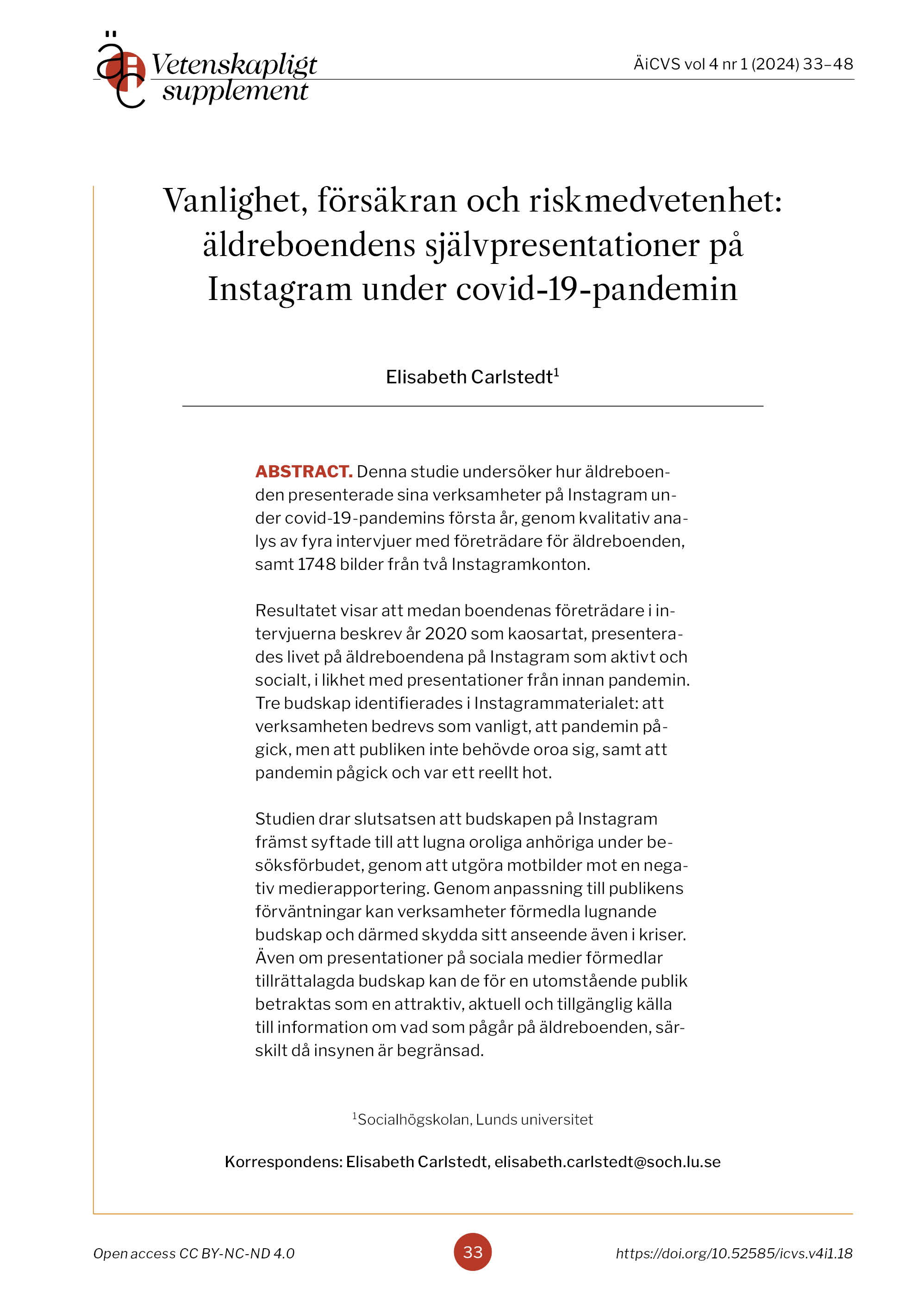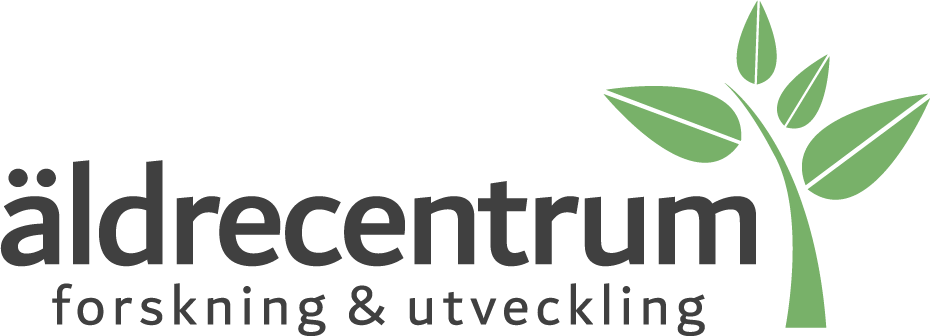Vanlighet, försäkran och riskmedvetenhet: äldreboendens självpresentationer på Instagram under covid-19-pandemin
DOI:
https://doi.org/10.52585/icvs.v4i1.18Abstract
Denna studie undersöker hur äldreboenden presenterade sina verksamheter på Instagram under covid-19-pandemins första år, genom kvalitativ analys av fyra intervjuer med företrädare för äldreboenden, samt 1748 bilder från två Instagramkonton.
Resultatet visar att medan boendenas företrädare i intervjuerna beskrev år 2020 som kaosartat, presenterades livet på äldreboendena på Instagram som aktivt och socialt, i likhet med presentationer från innan pandemin. Tre budskap identifierades i Instagrammaterialet: att verksamheten bedrevs som vanligt, att pandemin pågick, men att publiken inte behövde oroa sig, samt att pandemin pågick och var ett reellt hot.
Studien drar slutsatsen att budskapen på Instagram främst syftade till att lugna oroliga anhöriga under besöksförbudet, genom att utgöra motbilder mot en negativ medierapportering. Genom anpassning till publikens förväntningar kan verksamheter förmedla lugnande budskap och därmed skydda sitt anseende även i kriser. Även om presentationer på sociala medier förmedlar tillrättalagda budskap kan de för en utomstående publik betraktas som en attraktiv, aktuell och tillgänglig källa till information om vad som pågår på äldreboenden, särskilt då insynen är begränsad.
Normality, assurance, and risk awareness: Nursing homes’ self-presentations on Instagram during the Covid-19 pandemic
This study examines how nursing homes presented their daily activities on Instagram during the first year of the covid-19 pandemic, through a qualitative analysis of four interviews with representatives of these facilities and 1748 images from two Instagram accounts.
The results show that while representatives described the year 2020 as chaotic in the interviews, life in nursing homes was presented on Instagram as active and sociable, similar to presentations from before the pandemic. Three messages were identified in the Instagram material: that the daily activities were running as usual, that the pandemic was ongoing but the audience did not need to worry, and that the pandemic was ongoing and posed a real threat.
The study concludes that the messages on Instagram were primarily aimed at reassuring concerned family members during the visitation ban by providing counter-images to negative media reports. By adapting to the audience’s expectations, nursing homes can convey reassuring messages and thereby protect their reputation even in crises. Although social media presentations may convey curated messages, they can be perceived by an external audience as an attractive, current, and accessible source of information about what is happening in nursing homes, especially when transparency is limited.
Referenser
Almgren SM, Olsson T. ”Let’s get them involved”... to some extent: Analyzing online news participation. Social media + society. 2015;1(2):1-11. https://doi.org/10.1177/2056305115621934
Alvesson M. Organization: From substance to image? Organization studies. 1990;11(3):373-94. https://doi.org/10.1177/017084069001100303
Björne P. As if living like others: An idealisation of life in group homes for people with intellectual disability. Journal of intellectual and developmental disability. 2020;45(4): 337-43. https://doi.org/10.3109/13668250.2020.1793451
Bohlin G, Bergman M, Bronéus F. Allmänhetens syn på medierapporteringen om corona. I: Andersson U, Bergman M, Bohlin G, Brounéus F, Dahlgren P, Ekdahl E m fl, redaktörer. Journalistik i coronans tid. Institutet för mediestudier, Stockholms universitet; 2021. s. 144-55.
Braun V, Clarke V. Using thematic analysis in psychology. Qualitative research in psychology. 2006;3:77-101. https://doi.org/10.1191/1478088706qp063oa
Brunsson N. Ideas and actions: Justification and hypocrisy as alternatives to control. Accounting, organizations and society. 1993;18(6):489-506. https://doi.org/10.1016/0361-3682(93)90001-M
Brunsson N. Organizing for inconsistencies: On organizational conflict, depression and hypocrisy as substitutes for action. Scandinavian journal of management studies. 1986;2(3-4):165-85. https://doi.org/10.1016/0281-7527(86)90014-9
Carlstedt E. A fun, active and sociable life on display – Nursing home presentations on Instagram. Ageing and society. 2019;39(9):2109-32. https://doi.org/10.1017/S0144686X18000454
Carlstedt E. Ratings, rankings and managing numbers : Professionals’ perspectives on user surveys in Swedish nursing home care. Social policy and administration. 2021;55(7):1356-69. https://doi.org/10.1111/spol.12730
Carlstedt E, Jönson H. Amazing numbers and bottom rankings: the reporting of nursing home resident user surveys in the press. International journal of sociology and social policy. 2021;41(11/12): 1265-77. https://doi.org/10.1108/IJSSP-07-2020-0266
Carlstedt E, Jönson H. Anhöriga till äldre på särskilt boende – roller och positioner. I: Klingberg G och Hallberg U, redaktörer. Stora anhörigboken. Studentlitteratur; 2023. s. 179-202.
Carlstedt E, Jönson H. Online representations of nursing-home life in Sweden: Perspectives from staff on content, purpose and audience. Ageing and society. 2020;40(12):2754-70. https://doi.org/10.1017/S0144686X19000941
Christensen T, Lægreid P. The coronavirus crisis – crisis communication, meaning-making, and reputation management. International public management journal. 2020;23(5):713-29. https://doi.org/10.1080/10967494.2020.1812455
Coombs WT. Protecting organization reputations during a crisis: The development and application of situational crisis communication theory. Corporate reputation review. 2007;10(3):163-76. https://doi.org/10.1057/palgrave.crr.1550049
Coronakommissionen. Äldreomsorgen under pandemin (SOU 2020:80). Norstedts juridik.
Couldry N, Hepp A. The mediated construction of reality. Polity press; 2016.
DiMaggio PJ, Powell WW. The iron cage revisited: Institutional isomorphism and collective rationality in organizational fields. American sociological review. 1983;48(2):147-60. https://doi.org/10.2307/2095101
Erlandsson S. Hjälp för att bevara eller förändra? Åldersrelaterade diskurser om omsorg, stöd och service [doktorsavhandling]. Stockholms universitet; 2014. Rapport i socialt arbete nr 145.
Erlandsson S, Storm P, Stranz A, Szebehely M, Trydegård G-B. Marketising trends in Swedish eldercare: Competition, choice and calls for stricter regulation. I: Meagher G, Szebehely M, redaktörer. Marketisation in Nordic eldercare: A research report on legislation, oversight, extent and consequences. Institutionen för social arbete, Stockholms universitet; 2013. Stockholm studies in social work 30. s. 23-83.
Erlandsson S, Ulmanen P, Wittzell S. Covid-19 på äldreboenden – personalens erfarenheter. SNS Förlag; 2023.
Fannes G, Claeys A-S. Putting empathic feelings into words during times of crisis: The impact of differential verbal empathy expressions on organizational reputation. Public relations review. 2022;48(2):e102183 [12 s]. https://doi.org/10.1016/j.pubrev.2022.102183
Gubrium JF, Holstein JA. The constructionist mosaic. I: Holstein JA och Gubrium JF, redaktörer. Handbook of constructionist research. Guilford press; 2008. s. 3-10.
Haglund A. Anhöriga oroliga när boenden inte informerar. Aftonbladet. 24 april 2020.
Hjarvard S. The mediatization of society. A theory of the media as agents of social and cultural change. Nordicom review. 2008;29(2):105-34. https://doi.org/10.1515/nor-2017-0181
Huang M, Ki E-J. Protecting organizational reputation during a para-crisis: The effectiveness of conversational human voice on social media and the roles of construal level, social presence, and organizational listening. Public relations review. 2023;49(5):e102389 [11 s]. https://doi.org/10.1016/j.pubrev.2023.102389
Johansson B, Ihlen Ø, Lindholm J, Blach-Ørsten M, redaktörer. Communicating a pandemic: Crisis management and Covid-19 in the Nordic countries. Nordicom; 2023. https://doi.org/10.48335/9789188855688
Johansson B, Ihlen Ø, Lindholm J, Blach-Ørsten M. Introduction: Communicating a pandemic in the Nordic countries. I: Johansson B, Ihlen Ø, Lindholm J, Blach-Ørsten M, redaktörer. Communicating a pandemic: Crisis management and Covid-19 in the Nordic countries. Nordicom; 2023. s. 11-30. https://doi.org/10.48335/9789188855688-1
Kompani, K, Deml MJ, Mahdavian F, Koval O, Arora S, Broqvist H. Who said what: A multi-country content analysis of European health organisations’ Covid-19 social media communication. International journal of public health. 2022;67:e1604973 [12 s]. https://doi.org/10.3389/ijph.2022.1604973
Lindholm J, Carlson T, Albrecht F, Hermanson H. Communicating Covid-19 on social media. Analysing the use of Twitter and Instagram by Nordic health authorities and prime ministers. I: Johansson B, Ihlen Ø, Lindholm J, Blach-Ørsten M, redaktörer. Communicating a pandemic: Crisis management and Covid-19 in the Nordic countries. Nordicom; 2023. s. 149-72. https://doi.org/10.48335/9789188855688-7
Liu H, Liu W, Yoganathan V, Osburg VS. Covid-19 information overload and generation Z’s social media discontinuance intention during the pandemic lockdown. Technological forecasting and social change. 2021;166:e120600 [12 s]. https://doi.org/10.1016/j.techfore.2021.120600
Mahon J, Wartick S. Dealing with stakeholders: How reputation, credibility and framing influence the game. Corporate reputation review. 2003;6(1):19-35. https://doi.org/10.1057/palgrave.crr.1540187
Markström C, Ljuslinder K, Sjöström S. Konsensus och personifierade konflikter: Problembeskrivningar av äldreomsorg i svensk dagspress. Sociologisk forskning. 2011;48(1):5-23. https://doi.org/10.37062/sf.48.18417
Miller EA, Ronneberg CR, Livingstone I. The tone of nursing home portrayal in 51 newspapers in the United states. World medical and health policy. 2018;10(2):146-68. https://doi.org/10.1002/wmh3.268
Morath LP, Burström B, Liljas AEM. Care home managers' views on the media coverage of Covid-19 outbreaks in care homes for older adults: A case study in Stockholm. International journal of older people nursing. 2022;17(6):e12483 [6 s]. https://doi.org/10.1111/opn.12483
O'Mahony K. Patient fick palliativ vård utan att anhöriga informerades. Vårdfokus. 28 oktober 2021.
Park K, Jiang H. Signaling, verification, and identification: The way corporate social advocacy generates brand loyalty on social media. International journal of business communication. 2023;60(2):439-63. https://doi.org/10.1177/2329488420907121
Power M, Scheytt T, Soin K, Sahlin K. Reputational risk as a logic of organizing in late modernity. Organization studies. 2009;30(2-3):301-24. https://doi.org/10.1177/0170840608101482
Price KN, Gioia DA, Corley KG. Reconciling scattered images: Managing disparate organizational expressions and impressions. Journal of management inquiry. 2008;17(3):173-85. https://doi.org/10.1177/1056492608314991
Prior L. Using documents in social reseach. Sage publications; 2003. https://doi.org/10.4135/9780857020222
Saud M, Mashud MI, Ida R. Usage of social media during the pandemic: Seeking support and awareness about Covid-19 through social media platforms. Journal of public affairs. 2020;20(4):e2417 [9 s]. https://doi.org/10.1002/pa.2417
Shanks E, Lundström T, Meagher G, Sallnäs M, Wiklund S. Impression management in the market for residential care for children and youth in Sweden. Social policy and administration. 2021;55:82-9. https://doi.org/10.1111/spol.12613
Socialstyrelsen. Öppna jämförelser 2023. Resultat från undersökningen ”Vad tycker de äldre om äldreomsorgen?” Socialstyrelsen; 2023.
Socialstyrelsen. Övergripande statistik över avlidna i covid-19. Socialstyrelsen; 2023.
SVT Nyheter. 40 äldreboenden sticker ut – fördubblad dödlighet under coronavåren [tv-program]. Sveriges television. 2 juni 2020.
SVT Nyheter. SVT granskar: ”Nu är min pappa bara en siffra i statistiken” [tv-program]. Sveriges television. 24 januari 2021.
Söderberg M. Hänsynstagandets paradoxer: Om äldre, närstående och biståndshandläggare vid flytt till särskilt boende [doktorsavhandling]. Socialhögskolan, Lunds universitet; 2014.
Vingare E-L. Paradoxer i välfärden: När anhöriga blir lösningen på demensomsorgens utmaningar [doktorsavhandling]. Linnéuniversitet; 2019.
Watkins B, Smith SA. I want to work there: how public relations agencies communicate organizational culture and identity on Instagram. Journal of communication management. 2022;26(1): 58-83. https://doi.org/10.1108/JCOM-01-2021-0005
Whitaker A. Livets sista boning: anhörigskap, åldrande och död på sjukhem [doktorsavhandling]. Stockholms universitet; 2004.

##submission.downloads##
Publicerad
Referera så här
Nummer
Sektion
Licens
Copyright (c) 2024 Elisabeth Carlstedt

Detta verk är licensierat under en Creative Commons Erkännande-Ickekommersiell-IngaBearbetningar 4.0 Internationell-licens.


